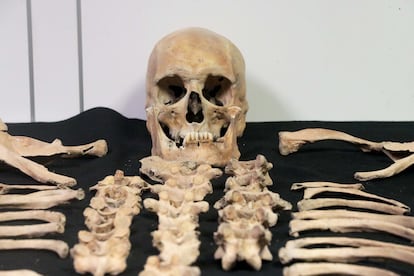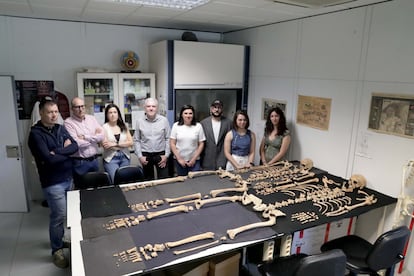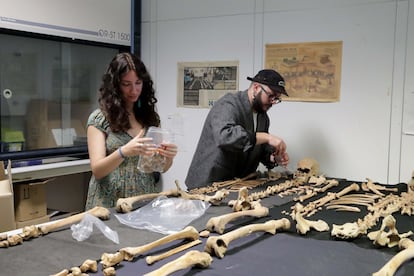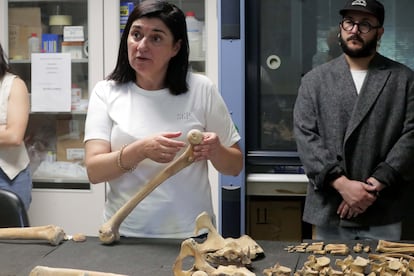Two Visigothic era skeletons rest on a table of a laboratory at the University of Burgos (UBU). The bones, between the 5th and VII centuries, maintain an optimal conservation that, after analyzing them, has allowed them to detect hernias or broken ribs. To these physical features, multiple indications are joined with which they try to confirm that they were buried in one of the first still preserved Christian temples of the Peninsula, from the seventh century, possibly built on a Roman mausoleum of the fourth century. Archaeologists and paleoanthropologists at the head of this project, developed in Montes Claros de Ubierna (Burgos), yearn for more resources to continue studying these historical clues. So far, science has ratified its suspicions with the ages of the dead and the hermitage. The team speaks, in conditional, with some smiles between the nerves and with the caution of the scientific field, at the expense of consolidating the keys collected since in 1996 that burgal hermitage began to be restored and some bones and old sarcophagi began.
In 2018, this project began with the Ades Archeology and Heritage team and archaeologists Óscar González and Gerardo Martínez worked together with members of Paleoantropology of the UBU, reference in the field with unique experiences such as those extracted from Atapuerca. González recites how these initial estimates were strengthened: the appearance in 2022 of “two intact sarcophagi with their original tenants” was encrypted in the seventh century and the skeletons, after submitting them to carbon tests 14, they were located in that Visigothic era. At the moment they know that they were a man and woman, in about 50 years, 1.69 meters he and 1.62 she, probably robust.
The decoration with marked concentric circles, very typical of the Visigothic style and appreciated in similar deposits of France or Central Europe, abrupt these thoughts. Both lay in the east-west direction, following the Christian tradition of looking at dawn as a symbol of resurrection, rite of the beginnings of peninsular Christianity, while Germanic peoples applied their Arian traditions.

“We were chasing ghosts until we have found it; now we are trying to contextualize the finding and ensure relationships between them,” says González, because they await the study of soils to certify that the hermitage, from the seventh and still standing, was erected on a Roman mausoleum of the fourth century. To date, the Basilica and necropolis of Santa Eulalia, in Mérida, around the seventh century, and the Palencia Temple of San Juan de Baños, from the seventh century, are considered the oldest in the Peninsula. José Miguel Carretero, Director of the Human Evolution Laboratory, Paleoantropologist and reference in the study of Atapuerca deposits, regrets the low public financing to historical research, thanks the involvement of the City Council of Merindad de Río Ubierna and the Diputación de Burgos, in addition to the expert team of the UBU, and reflects on the impact of the findings: “The cost of these studies is low and low. social;

Alba Navarro, Marta García and Julia Muñoz, Anthropologists and in preoctoral studies, listen to Nico Chirotto, laboratory technician. This young quartet celebrates attending these investigations beyond what was studied on paper and ink, as Muñoz summarizes: “It is a direct opportunity to interpret the past without biased texts.” Once the remains to journalists are shown, the bones return to the plastic bags and cardboard boxes where they will rest until they are studied again. It would be all easier for coming civilizations, they joke, if when we die we put labels with our features.
The Sarcophagi, with white limestone, wait in the Renaissance patio of the Provincial Museum of Burgos, shelter of multiple remains of disparate times where the current province had its own artistic and historical weight. González and Martínez explain the “open heart operation” that meant excavating in those land to extract these heavy stone pieces. First, it was necessary to pour below the set, about two meters deep, to be able to take them out. It was the first time, they add, that a work of this complexity and characteristics did not execute on the ground, since that rainy fall of 2022 demanded to move them, take them out with care and locate them in the museum to scrutinize them conscientiously. The only damage, a blow to one of the blocks, collateral victim for science. So arduous was the process that a documentary recorded, first next to the hermitage and then in the subsequent actions: when exposing it in Burgos there were people who even cried with emotion.

Martínez remembers the surprise when the sarcophagi appears: “At first I thought they were remains of a column.” Subsequent actions revealed two water accesses in different times judging by silt and the bones removed, as the heavy ones (femur, warm) endured and the minors (Falanges, ribs) spread through the stone coffin. There was a brown silt, they believe, from a water input shortly after the burial; Another, white, blame it for leaks and the use of lime on the wall built on them in the seventh century, but not before putting a layer of protective land, a sign that the existence of the necropolis was known. Luis Araus, Museum Director. Araus underlines the dedication of the group to draw key conclusions for the period and recalls the vestiges of other centuries and millennia in these lands, where treasures still emerge like those sarcophagi: “Just before a lady has told us that she has found one like that in the garden.”

